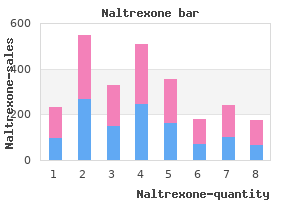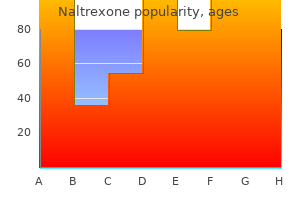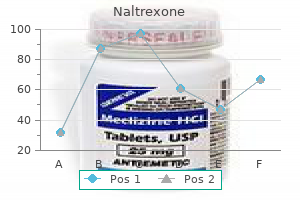"Purchase naltrexone no prescription, symptoms lyme disease".
By: M. Kerth, M.A., M.D., M.P.H.
Co-Director, New York Institute of Technology College of Osteopathic Medicine at Arkansas State University
Human trafficking treatment emergent adverse event purchase 50 mg naltrexone free shipping, particularly for sexual exploitation treatment 8th february naltrexone 50mg line, is a cash-intensive criminal enterprise symptoms lung cancer purchase generic naltrexone on-line. Department of State treatment hepatitis c cheap naltrexone uk, Trafficking in Persons Report 2016, 72, 99; David Gagne, "Organized Crime Profits from Modern Slavery in Latin America," InSight Crime, June 3, 2016. Money transmitters are useful in repatriating proceeds to source countries, with funds being sent by victims to families back home or by the groups to finance other criminal activities. Companies engaged in cross-border trade also use misinvoicing to launder and repatriate their illicit proceeds. Developing Countries Human trafficking has serious security and economic impacts on individuals, communities, and countries. Countries also lose much-needed remittances, human capital, and tax revenues as a result of trafficking and forced labor. The criminal activity and corruption associated with human trafficking undermine domestic stability and rule of law. When victims are trafficked internationally, source countries lose human resources without a corresponding increase in remittances. Regular and irregular migration constitute a loss of human capital for source countries,120 however migrants receive relatively fair wages and typically send a portion of their earnings back to their home countries. When trafficking victims are paid a wage, the remittances to their home country are typically much lower than regular or irregular migrants who are not exploited. A study of sex 116 117 118 Organization for Security and Co-operation in Europe, Leveraging Anti-Money Laundering Regimes, 14. Businesses that use forced labor likely engage in tax evasion by not paying payroll taxes, thereby reducing government revenues. Forced labor greatly reduces input and production costs, allowing companies to charge lower prices, which undercuts companies that adhere to fair labor practices. Trafficking subjects victims to a myriad of human rights abuses including the deprivation of liberty and the violation of the right to fair wages and security of person. Victims of sexual exploitation regularly face social consequences such as stigmatization when they return home. In some countries, such as India, whole families can be trapped by debt bondage, as individuals are forced to assume the debts taken on by their parents and grandparents. Political, economic, environmental, and social crises as well as armed conflict exacerbate pre-existing conditions that already leave individuals and populations vulnerable to human trafficking. The economic impacts can force individuals to seek alternative income sources, overlooking possible risks to their safety and freedom, while reallocated government services reduce social protections for citizens. These groups use labor and sexual exploitation as a tactic to acquire fighters and funding as well as to subjugate opponents. The spread of the internet has provided traffickers with additional, far-reaching means to reach both potential victims and victimizers. Human trafficking is playing a growing role in terrorist and insurgent activities and groups. Traffickers use social media and deceptive online advertisements to recruit individuals for both sex and labor trafficking. While most victims are trafficked for labor exploitation, trafficking for sexual exploitation generates the greatest profits. With 21 million victims, trafficking of persons also has the greatest impact on human rights and security, especially in developing countries. Traffickers exploit vulnerable populations through the use of deception, coercion, and force. Labor and sexual exploitation cause developing countries to lose human capital, remittances, and tax revenues, creating obstacles to development. In recent years, terrorist and insurgent groups have been engaging in human trafficking to finance operations, recruit and/or reward fighters, and demoralize opponents. The internet has also been providing traffickers with greater access to (potential) victims and victimizers, allowing them to expand their business. Department of State, Trafficking in Persons Report 2016, 75, 99, 121, 144, 218, 229, 273, 398.

The placement of the feeding tube through the pylorus into the fourth portion of the duodenum reduces the risk of regurgitation and aspiration of feeding formulas symptoms pancreatitis discount naltrexone amex. To place a transnasal intraduodenal feeding catheter medicine in the civil war trusted naltrexone 50mg, the patient should be in the sitting position with the neck slightly flexed symptoms 24 hour flu purchase 50 mg naltrexone visa. The head is brought back to a neutral position and the patient is instructed to swallow while the feeding catheter is simultaneously passed down into the esophageal lumen medications rights purchase 50mg naltrexone with amex. Once the catheter is confirmed to be in the stomach by injecting air while listening over the epigastrium, the patient is laid on the right side and the tube is advanced another 15 to 20 cm. This should position the tube into the duodenum and can be confirmed by listening over the right upper quadrant while advancing the tube. The stylette is removed and the position of the catheter is confirmed radiographically before the initiation of feedings. Gastric feedings are initiated by a bolus test volume of saline, representing the hourly feeding volume infused over 1 hour, into the stomach. If less than 50% of the volume load returns, then the selected volume is appropriate. In general, duodenal feedings can be started at 25 mL/hr at full-strength concentration unless the patient has been at bowel rest for several days, in which case the formula should be diluted to one-fourth strength. In such patients, we generally increase the rate of infusion before increasing the concentration. Despite these precautions, approximately 10% to 20% of patients receiving enteral feedings develop some degree of diarrhea secondary to malabsorption and the osmotic load of the feedings. When this occurs, decrease the rate of feeding by 50% rather than stopping the feedings altogether. In patients with an unresectable esophageal carcinoma who are not surgical candidates or in individuals who are unable to maintain caloric needs, a permanent gastrostomy should be considered. A temporary Stamm gastrostomy is a popular method for access to the gastric lumen that can be performed at the time of any major abdominal procedure. If the patient tolerates catheter elevation, we advance enteral feedings as described previously. Percutaneous endoscopic gastrostomy to provide access for gastric feedings can be performed without a laparotomy or general anesthesia. Transabdominal illumination with the endoscopic light source selects an area on the anterior abdominal wall, usually halfway between the costal margin and the umbilicus. Local anesthesia is injected over the site followed by the insertion of an Angiocath percutaneously into the stomach. A wire is passed through the Angiocath, grabbed by a snare that has been passed through the endoscope, and pulled back with the endoscope out of the mouth. A standard percutaneous gastrostomy tube with a wire loop is attached to the guidewire and pulled back down the esophagus and out through the abdominal wall. The endoscope is passed back with the tube and the catheter is pulled under direct visualization until taut and then sutured to the abdominal wall. Inability to pass the endoscope safely or to identify the transabdominal illumination of the endoscope tip within the dilated stomach are contraindications to the procedure. Ascites, coagulopathies, and intraabdominal infections are relative contraindications as well. The simplest method is a needle catheter jejunostomy, which can be performed fairly quickly at the end of the definitive operation. The entire length of a 14-gauge needle is used to create a subserosal tunnel approximately 30 to 40 cm distal to the ligament of Treitz and then the needle tip is introduced into the jejunal lumen. A 16-gauge feeding catheter is inserted through the needle and advanced 30 to 40 cm distally into the bowel lumen and the needle is withdrawn. The catheter is secured to the jejunal wall with sutures and then the loop of jejunum is anchored to the parietal peritoneum. The needle catheter jejunostomy is generally removed 2 to 4 weeks postoperatively when no longer needed. The placement technique is simple Witzel tunnel 128 and takes only 10 to 15 minutes. Jejunal feeding catheters can be used immediately for feeding purposes following the operation. Catheter care is essential to maintain patency, and the nursing staff need to flush the catheter with saline every 8 hours to ensure adequate patency. However, these solutions must be nearly isotonic to avoid peripheral vein sclerosis.

Itraconazole has been shown to be effective in cases of phaeohyphomycosis refractory to amphotericin B symptoms 6 days dpo order naltrexone 50mg line. Fusarium Species Fusarium species are soil saprophytes that have been associated with soft tissue infection medications for schizophrenia buy naltrexone 50mg line, onychomycosis symptoms viral infection cheap 50 mg naltrexone overnight delivery, and keratitis in immunocompetent hosts symptoms jaw pain buy naltrexone 50 mg visa. In the absence of a definitive culture diagnosis, the likelihood of infection by a Fusarium species is substantially increased by the presence of disseminated cutaneous lesions and isolation of a mold from blood culture. Boutati and Anaissie 155 made important observations about invasive and disseminated fusariosis in a retrospective review of 43 cases occurring in patients with hematologic malignancies at M. Most cases of disseminated fusariosis were diagnosed during neutropenia, and a high risk of relapse was associated with subsequent myelosuppression. Initial localized manifestations included onychomycosis, paronychia, and cellulitis. Inhalation of spores is another major portal of entry, leading to fungal sinusitis and pneumonia. Survival from disseminated fusariosis is critically dependent on resolution of neutropenia. Scedosporium Species Scedosporium apiospermum (Pseudallescheria boydii) and Scedosporium prolificans are the principal pathogenic species in the genus Scedosporium. In neutropenic patients, P boydii is a virulent pathogen, which clinically and histologically resembles aspergillosis. Establishing a culture diagnosis of P boydii is important because of its frequent resistance to amphotericin B. P boydii is usually susceptible to azoles, and in vitro studies and some clinical experience suggest that the combination of amphotericin B plus an azole. S prolificans causes a similar spectrum of disease as P boydii and is generally resistant to all antifungal agents. These organisms include Histoplasma capsulatum, Coccidioides immitis, Blastomyces dermatitidis, and Penicillium marneffei (P marneffei is endemic in Southeast Asia). These fungi are dimorphic, existing in nature in the mycelial stage, and convert to yeast stage at body temperature. Because some of these pathogens may be quiescent during the initial infection and only manifest clinically during a subsequent period of severe depression or cell-mediated immunity, a detailed travel history is essential. Endemic mycoses in the central United States include histoplasmosis and blastomycosis. In the immunocompetent host, inhalation of Histoplasma microconidia is typically asymptomatic, but may manifest with acute fever, pulmonary infiltrates, and hypoxia. The chest radiograph may show a miliary reticulonodular appearance, suggestive of tuberculosis. An acute sepsis syndrome with hypotension and disseminated intravascular coagulation, adrenal crisis, and meningitis are additional potentially lethal complications. A rapid diagnosis of histoplasmosis can be made by Giemsa staining of a peripheral blood smear of bone marrow aspirate demonstrating characteristic intracellular yeast forms. Antigen detection from blood and urine is a sensitive and specific method in disseminated disease. Biopsy of specimens may show intracellular or narrow budding yeasts suggestive of the diagnosis, which should be confirmed by culture. In the immunocompromised patient, histoplasmosis should be treated with high-dose amphotericin B (1. Prolonged therapy with itraconazole may be initiated after stabilization of disease and should probably be continued for the duration of immunosuppression. Blastomyces dermatitides may present as an acute pulmonary infection resembling bacterial pneumonia, or as a chronic infection resembling tuberculosis or lung cancer. Skin disease resulting from direct inoculation includes large ulcerative and verrucous lesions.

Histopathologic and immunohistochemical changes in gut-associated lymphoid tissues after treatment of rabbits with dexamethasone medications not to take after gastric bypass purchase naltrexone with paypal. Prevention of corticosteroid-induced suppression of human polymorphonuclear leukocyte-induced damage of Aspergillus fumigatus hyphae by granulocyte colony-stimulating factor and gamma interferon medicine 0636 purchase 50 mg naltrexone overnight delivery. Infectious complications of immunosuppressive therapy in patients with rheumatic diseases treatment action campaign order naltrexone pills in toronto. Decreased serum IgG concentration caused by 3 or 5 days of high doses of methylprednisolone symptoms stomach ulcer buy 50 mg naltrexone otc. Interaction between trimethoprim-sulfamethoxazole and methotrexate in children with leukemia. Brief report: reversible lymphomas associated with Epstein-Barr virus occurring during methotrexate therapy for rheumatoid arthritis and dermatomyositis. A randomized trial comparing use of cyclosporin and methotrexate for graft-versus-host disease prophylaxis in bone marrow transplant recipients with haematological malignancies. Cyclosporin A is associated with faster engraftment and less mucositis than methotrexate after allogeneic bone marrow transplantation. Listeriosis in patients with chronic lymphocytic leukemia who were treated with fludarabine and prednisone. Results of fludarabine and prednisone therapy in 264 patients with chronic lymphocytic leukemia with multivariate analysis-derived prognostic model for response to treatment. Opportunistic pulmonary infections with fludarabine in previously treated patients with low-grade lymphoid malignancies: a role for Pneumocystis carinii pneumonia prophylaxis. An acquired chemotactic defect in neutrophils from patients receiving interleukin-2 immunotherapy. Normal IgG and impaired IgM responses to polysaccharide vaccines in asplenic patients. Decreased susceptibility of Streptococcus pneumoniae to fluoroquinolones in Canada. Capnocytophaga canimorsus infections in human: review of the literature and cases report. Pathways of T-cell regeneration in mice and humans: implications for bone marrow transplantation and immunotherapy. Proliferative and differentiative responses of B cells from human marrow graft recipients to T cell-derived factors. T cell functional defect associated with thymic epithelial cell injury induced by a graft-versus-host reaction. Origin of infection in acute lymphocytic leukemia: significance of hospital acquisition of potential pathogens. Nosocomial bloodstream infections in United States hospitals: a three-year analysis. The development of vancomycin resistance in a patient with methicillin- resistant Staphylococcus aureus infection. Control of an outbreak of an epidemic methicillin-resistant Staphylococcus aureus also resistant to mupirocin. The efficacy and safety of quinupristin/dalfopristin for the treatment of infections caused by vancomycin-resistant Enterococcus faecium. In vitro activities of linezolid against important gram-positive bacterial pathogens including vancomycin-resistant enterococci. Septicemia and shock syndrome due to viridans streptococci: a case-control study of predisposing factors. Activities of potential therapeutic and prophylactic antibiotics against blood culture isolates of viridans group streptococci from neutropenic patients receiving ciprofloxacin. Outcomes of bacteremia in patients with cancer and neutropenia: observations from two decades of epidemiological and clinical trials. Antimicrobial susceptibility of vancomycin-resistant Leuconostoc, Pediococcus, and Lactobacillus species. A functional classification scheme for beta-lactamases and its correlation with molecular structure.

Use of electron microscopy 297 and immunoperoxidase staining298 may facilitate diagnosis medications xanax purchase naltrexone once a day. Visualization of the organism in cerebrospinal fluid using Giemsa staining is diagnostic of disease medications and grapefruit juice generic naltrexone 50mg on-line, but the sensitivity of this method is low medications given for uti naltrexone 50mg otc. The treatment of choice for toxoplasmosis is oral sulfadiazine treatment yeast order naltrexone 50 mg on-line, 4 to 6 g/d, plus pyrimethamine (loading dose of 200 mg, followed by 50 to 75 mg daily). It is reasonable to continue a maintenance regimen (which may consist of sulfadiazine, 2 g/d, plus pyrimethamine, 50 mg/d) during periods of immunosuppressive therapy. In patients intolerant of sulfonamides, clindamycin and primaquine may be used instead. Skin manifestations include persistent ulcers, nodules, or subcutaneous abscesses. A diagnosis may be established by cerebrospinal fluid analysis or biopsy showing characteristic amebic trophozoites. Cross-infection between humans through contact with material soiled with feces appears to be likely in overcrowded and unsanitary conditions. This underscores the need to obtain a thorough history about prior residence in endemic areas. Corticosteroid therapy with and without other agents appears to be associated with the highest risk of disseminated disease. Sites of dissemination include the lungs, lymph nodes, brain, and abdominal organs. Secondary bacterial infection presumably results from passage of enteric bacteria through the bowel as a consequence of gastrointestinal strongyloidiasis, and may result in peritonitis, bacteremia, and meningitis. Diagnosis of infection relies on visualization of larvae in feces, duodenal aspirates, sputum samples, or in other body fluids or tissue. Although uncommon, patients from endemic areas should be screened for S stercoralis carriage, ideally before receiving immunosuppressive agents. Patients with S stercoralis infection should be treated with thiabendazole or ivermectin. For the purpose of this discussion, we use the following established criteria for neutropenic fever: 1. Evaluation of the febrile neutropenic patient begins with a careful history and physical examination. A history of prior infectious complications associated with chemotherapy may be useful for risk stratification and selecting an empiric regimen. For example, a history of recent colitis caused by Clostridium difficile raises the likelihood of recurrent infection in a patient with fever and diarrhea. Prior invasive candidiasis or infection by one of the filamentous fungi may recur during subsequent neutropenic periods. Concomitant use of corticosteroid therapy raises the likelihood of opportunistic pathogens, such as P carinii, that characteristically afflict patients with defects in cell-mediated immunity. For example, swimming or fishing in fresh or brackish waters raises the possibility of infection by Aeromonas hydrophilia. Exposure to salt water increases the likelihood of infection by Vibrio vulnificus. A meticulous physical examination is necessary, bearing in mind that typical signs of infection may be blunted or absent as a result of immunosuppression. In patients with prolonged neutropenia or who receive concomitant high-dose corticosteroid therapy, fungal infection of the palate, typically by Zygomycete or Aspergillus species, constitutes a surgical emergency. Palpation over the anterior sinuses and an ophthalmologic examination should be performed. A detailed inspection of the skin, including the nails, may disclose a lesion suggestive of systemic infection or a possible portal of entry. Examples include ecthyma gangrenosum caused by P aeruginosa, or erythematous papules caused by disseminated candidiasis. Catheter sites and sites of prior skin penetration (such as surgical wounds and biopsy sites) should be palpated.
Purchase generic naltrexone line. Alcohol & Drug Treatment - Post Acute Withdrawal Syndrome.


